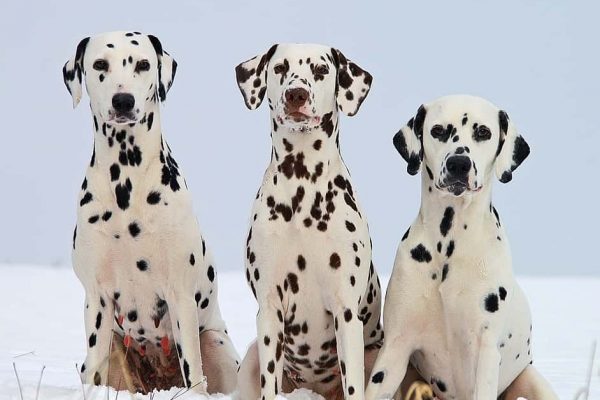Feeding your Dalmatian twice daily should be a good way to go. On average 2 cups of dry food should be ok for them per day. Be on the lookout for dog food that is low in purines to reduce the risk of them getting kidney stones. Also, make sure that you provide lots of water for them also to avoid kidney stones and urinary infections.
Be sure to discuss with your vet doctor any change in weight or eating habits so that the problem can be addressed as early as possible
Even though the Dalmatian has a smooth white coat with spots of distinct colors. They are heavy shedders, this in turn means that they require more grooming than would be normal. Brushing their coat regularly (at least every other day) can help to minimize the shedding. The good thing about their coat is that it is dirt repellant. This means they can easily shed off any mud or debris that tries to hang onto their body.
Do not forget to routinely clean their ears and trim their nails, this is an easy way to avoid your dog becoming infected with any germs or bacteria
Dalmatians are smart dogs with the advantage of long term memory, so they should be easy to train. The main problem when trying to train a dalmatian is their energy level. Their hyperactivity makes them look untrainable, but in actual sense, they are taking in whatever is being taught. That is why it is very important to set down basic rules of interaction when it comes to your dalmatian.
Having them understand how they should act around you would set the proper tone for any training you want to give this dog
Dalmatians are active dogs and require lots of exercises to be calm. They have a great affinity for horses, which can be seen as one of the reasons why they love active life. A dalmatian should be exercised at least two hours daily for it to maintain its calm. This includes walking and running time. A word of warning, be sure to have your dalmatian on a leash whenever you go on these walks, if not they can bolt out on you leading you on a long chase instead of a nice walk or run at your own pace
Even though responsible breeders make a good effort to maintain the highest breed standards as established by renowned kennel clubs like the AKC. The Dalmatian as a breed is prone to some health problems. These are some of the main health challenges that can come with a Dalmatian dog.
Deafness: Approximately 12% of dalmatian dogs are born deaf and about 25% of them have some hearing problem.
Hip Dysplasia: This is an inherited condition that can produce lameness and arthritis.
Skin Allergies: Dalmatians are known to be prone to food-based allergies, contact allergies, or inhalant allergies.
Urinary Issues (infections, stones): This affects nearly all dalmatians dogs, there is the tendency for them to pass out more uric acid in their urine than other dog breeds would. This can lead to urinary infections and even Kidney stones. This is why it is very important to have them hydrated at all times. A dalmatian should not be made to lack drinking water to avoid this situation























